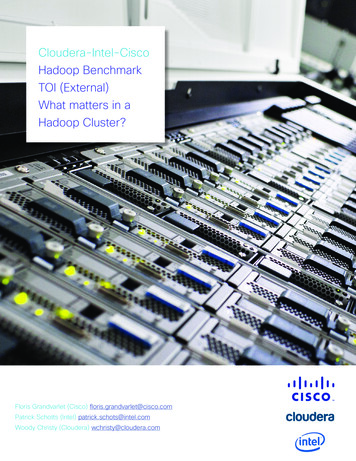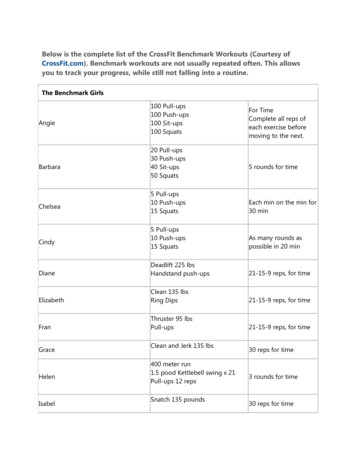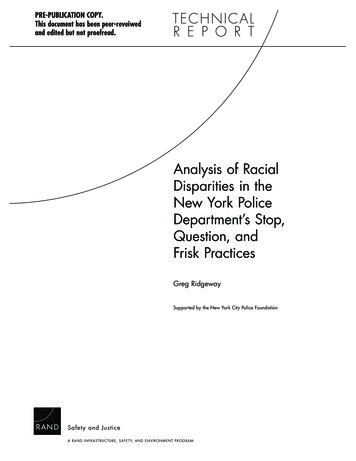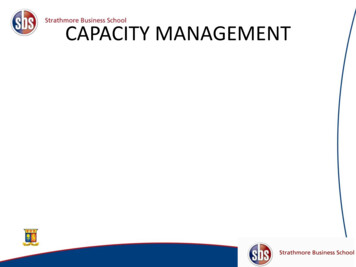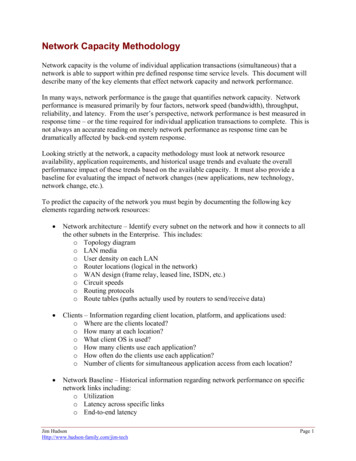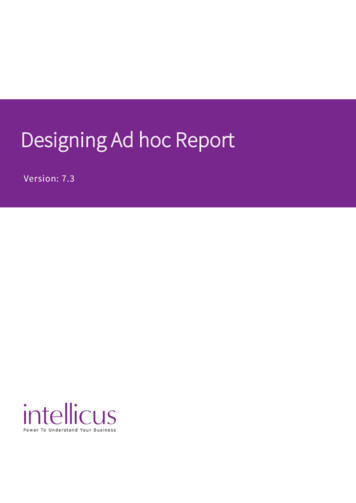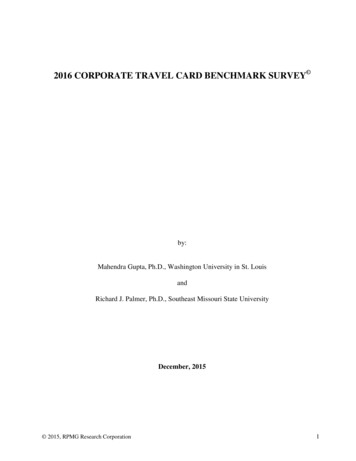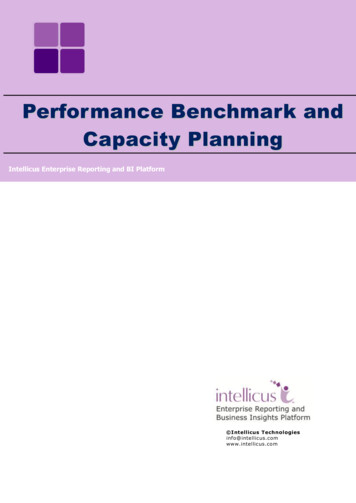
Transcription
Performance Benchmark and Capacity PlanningPerfor mance Benchmar k andCa pacity Planni ngIntellicus Enterprise Reporting and BI Platform Intellicus Technologiesinfo@intellicus.comwww.intellicus.com
Performance Benchmark and Capacity PlanningCopyright 2014 Intellicus TechnologiesThis document and its content is copyrighted material of Intellicus Technologies.The content may not be copied or derived from, through any means, in parts orin whole, without a prior written permission from Intellicus Technologies. Allother product names are believed to be registered trademarks of the respectivecompanies.Dated: March 2014Acknow ledg em ent sIntellicus acknowledges using of third-party libraries to extend support to thefunctionalities that they provide.For details, visit: http://www.intellicus.com/acknowledgements.htmii
Performance Benchmark and Capacity PlanningContentsIntroduction . 1Factors affecting the performance . 3Volume of data needed for the report . 3Size of a row, number of rows . 3Number of concurrent requests . 3Database . 3Network . 4Processor . 4RAM . 4Free hard disk space . 5Operating System . 6Number of user threads . 6Delivery Option . 6Operation / Action . 6Database connection Pool . 6Report . 7Capacity Limits . 9Report Performance Capacity Limits . 9Maximum Concurrent Users . 9Maximum Data that can be generated in Excel format . 10Maximum pages in a report that can be generated in PDF format . 11Maximum report pages that can be generated to HTML format . 11Maximum Data that can be generated to Raw Text format . 12Report Design and Preview: General observations . 13Intellicus portal UI Capacity Limits . 14Page loading times of Organization and Users related pages . 14Users . 15Report Design . 16Reports / Categories. 18Report Server . 21OLAP on File System . 22Benchmark tests and results . 23Scenarios . 23Machine configuration . 24Scenario 1: Data volume v/s concurrent users. 25Response time (1 st chunk) . 25Maximum CPU Usage. 26Contentsiii
Performance Benchmark and Capacity PlanningMaximum RAM Usage . 27Scenario 2: Data volume v/s output types . 28Report Execution time . 28Maximum CPU Usage. 29Maximum RAM Usage . 30Scenario 3: Chart report: Flash v/s Image . 31Report Execution Time . 31Maximum CPU Usage. 32Maximum RAM Usage . 33Scenario 4: Sub-reports . 34Report Execution time . 34Maximum CPU Usage. 35Maximum RAM Usage . 36Scenario 5: Logo images . 37Report execution time . 37Maximum CPU usage . 38Maximum Memory usage . 39Scenario 6: Report Complexity through scripting . 40Report execution time . 40Maximum CPU usage . 41Maximum RAM usage . 42Scenario 7: Report having groupings . 43Report execution time . 43Maximum CPU usage . 44Maximum RAM usage . 45Scenario 8: Resource usage trend for Standard Reports having 1000 records . 46CPU Usage . 46RAM usage . 47Scenario 9: iHTML Format (Expanded v/s Fetch on demand) . 48Report execution time . 48Maximum CPU usage . 49Maximum RAM usage . 50Scenario 10: OLAP Report Execution- Grid Only . 51Response time . 51Maximum CPU Usage. 52Maximum RAM Usage . 53Scenario 11: OLAP Report Execution- Grid and Chart . 54Response time . 54Maximum CPU Usage. 55Maximum RAM Usage . 56Contentsiv
Performance Benchmark and Capacity PlanningScenario 12: SMART Report Execution- Grid, Chart and Matrix . 57Response time . 57Maximum CPU Usage. 58Maximum RAM Usage . 59Scenario 13: SMART Report Execution- Different Chart Types . 60Response time . 60Maximum CPU Usage. 61Maximum RAM Usage . 62Capacity Planning . 63Calculating Concurrency Requirement . 63Created Application Users . 63Logged in Application Users . 63Concurrent Report Requests . 63Report Server CPU . 63Repository Services . 64Report Execution Services . 64Memory (RAM). 65Disk Space . 66Report Server . 66Portal . 67Windows Studio . 67Contentsv
Performance Benchmark and Capacity PlanningIntroductionAs a business enterprise, you will buy software after making sure that it hasfeatures meeting all of your enterprise reporting needs.You also expect the software to perform as per pre-defined parameters of normaland extreme usage conditions.This document provides information related to: Factors that affect Intellicus performance Intellicus capacity limits Benchmark results Tips on capacity planning and Performance tuning parameters.UI Capacity limits, gives an idea of how Intellicus portal reacts when a numberof users hit the same application page.Benchmark results and tips on capacity planning will assist you plan thehardware configuration for deployment of Intellicus.Make use of performance tuning parameters information to set properties ofIntellicus Server and get the performance levels that meet your needs.Introduction1
Performance Benchmark and Capacity PlanningFactors affecting the performancePerformance of Intellicus depends on multiple factors.Some of which areIntellicus internal factors, whereas others are external ones. You can controleffect of internal factors by setting properties of Intellicus Report Server as wellas Portal.Volume of data needed for the reportA report may need to process millions of rows of data before it can be view ed ordelivered. Large volume of data means longer time to: Fetch and transfer data from database server to report server. Process the data to construct report pages. Transfer of report pages from report server to browser.Size of a row, number of rowsReport data is fetched from the database using a SQL. Depending on the natureof report, its record-set may be of large size. This may happen due to factorslike number of fields, field size and type (for example, image field). Row sizemay contribute significantly in performance when a report has large size ofrecord-set. However, this factor will be insignificant for a report having lowvolume of data.Number of concurrent requestsReport Server allots one thread to each request. If number of r equests is morethan that of available threads, such requests are queued until a thread isreleased. More number of concurrent requests means more waiting time forqueued requests. How sooner a queued request is allotted a thread will dependon request type and data volume that running threads needs to process.DatabaseIntellicus depends on database for report data as well as meta -data. For almostevery user request, it has to query the repository for meta -data and query thebusiness database for report data. Business database may be receiving queriesfrom application other than Intellicus also.Factors like server hardware, connectivity and database schema will affectdatabase response time. And this will in turn, affect Intellicus response time.Factors affecting the performance3
Performance Benchmark and Capacity PlanningNetworkIntellicus supports distributed deployment of its server (report server) and client(portal) components.Users spread across wide geographical locations mayaccess Intellicus functionalities over corporate intranet or the Internet. In thiscase network will become a factor.Network SpeedNetwork resources are used to: Fetch data from database server to Report server Transfer reports from Report server to portal Transfer reports from portal to browserBandwidth consumed also depends on the volume of data that has to travel andso becomes a concern for a report having millions of rows.FirewallWhen a firewall is implemented all the content received are checked for pre-setparameters in order to filter the content. Filtering process takes some time andin turn effects all over performance of Intellicus.ProcessorIntellicus Report Server is a processor-intensive application. Depending on thenature of deployment and usage of Intellicus, it may have to serve a significantnumber of requests every second. The processor handles: Report execution requests. Repository update and administration tasks. Complex mathematical and logical operations for each of the report executionrequests.RAMIntellicus Report Server needs RAM for acti vities like:To keep data read from the result-set.This depends on data fetch size, which decides number of records fetched fromthe database at a time.Factors affecting the performance4
Performance Benchmark and Capacity PlanningFor internal sorting of recordsUser can dynamically sort records even after the report is exec uted. Since datahas already been fetched from database, sorting is carried out in RAM.To keep a minimal chunk of report pagesReport pages are kept in RAM before they are sent to the portal (and in turn,users). For a report having large number of pages, a minimum number of pagesare kept in RAM. Remaining report-pages are kept on disk. As and when a userrequests for specific pages, they are picked up from the disk and swapped withthose kept in RAM.Portal’s RAM needsIntellicus Portal needs RAM for activities like Retaining session details Streaming report pages or report files received from report server to browser.The amount of RAM required at a time will depend on specific Number of loggedin users, tasks they are requesting to Intellicus, etc.If an application’s memory requirement increases, operating system may useswapping so that application can continue running. In worst cases, applicationmay stop responding.Free hard disk spaceBefore generating final report output, Intellicus creates intermediate files. Whena report is requested in output formats like PDF or MS Word, Intellicus needs tocreate temporary files on report server’s local disk.Amount of required free disk space will depend on: Number of reports having high volume of data Report data cache settings Frequency of report generation Number and Validity period of published reports, etc.Factors affecting the performance5
Performance Benchmark and Capacity PlanningOperating SystemOperating systems have their respective capacities and limits of memory usageand process management, support for web server and web browser, etc.Intellicus is available for operating systems that support 32 -bit architecture aswell as 64-bit architecture.Number of user threadsIntellicus maintains separate threads for activitiesscheduler, dashboards, internal activities, etc.likereportgeneration,Each report server activity is allotted one thread. Requests received after all thethreads are consumed, are queued until a thread is freed.Delivery OptionIntellicus supports multiple report deli very options.Publish is relatively faster than other formats.A Report Delivery OptionReport output / delivery option that needs external resources or application maybe slower. E-mail: Number of reports that can be e-mailed in a set time will depend onthe capacity of the mail server. Upload (FTP): Time taken for uploading a report will depend on availablebandwidth as well as availability of the FTP server. View: Viewing a report in a specific output format takes one more cycle ofprocessing. In this cycle, the report is converted from intermediate format tothe requested format, for example, PDF.Operation / ActionResponse time of a request will depend on the type of operation / actionrequested, for instance, a repository update, report gene ration, etc. Reportgeneration actions generally take more time than repository update actions.Database connection PoolEach report generation request needs one connection with respective database.Having less number of open connections then required will keep query requestson hold until connections are freed and allotted to the queued requests.Factors affecting the performance6
Performance Benchmark and Capacity PlanningReportExecution of reports with extraordinary characteristics may take longer thenusual. For example, reports having: Comparatively complex queries Very large volume of data Large number of Cross-tabs Large number of charts, or charts having many series Sub reports within sub reportsFactors affecting the performance7
Performance Benchmark and Capacity PlanningCapacity LimitsThis section of the document provides capacity limits Information that will assistyou in comparing Intellicus capacity limits with your enterprise reporting needs(existing needs and future needs).Machine configurationSince the objective is to find limits, we selected a lower-end machine. Intellicusin production environment will have much bett er results.For example, if a report runs in one minute on a lower-end machine, it will runsignificantly faster on a higher-end report server. Processor: Intel(R) Core(TM) i5-3470CPU @3.20 GHz Report Server RAM: 8 GB Web Server RAM: 2 GB Platform: Windows 64 Bit Web Server: Jakarta TomcatReport Performance Capacity LimitsThis section depicts report execution related limitations. Small sized and bigsized reports were executed to receive output in multiple output formats like MSExcel, PDF, RAW TEXT, HTML and iHTML.Maximum Concurrent Users Small Reports: 40 Concurrent reports Big Reports: 10 Concurrent reportsORSmall sized reports mean a report having around 30 pages and row size in rangeof 100 – 150 characters. All the reports having larger row size or number ofpages are treated as big sized reports.If the requests exceed the above-mentioned limitations, then the response timeand throughput time may drastically increase as requests may pileup in thequeue.Capacity Limits9
Performance Benchmark and Capacity PlanningMaximum Data that can be generated in Excel formatThis test is to fetch huge number of rows, render report in multiple pages andthen generate Excel by checking single-sheet option and unzipped format.In this test, maximum available RAM for the report server was 512 MB. Row size: Normal (100-120 characters per row in 5 columns) Maximum rows: 600,000 Throughput Time: 20 minutes Request concurrency: 1Behaviour after crossing above limits Increase in the number of rows can cause report server to throw “out ofmemory” error. Increase in the number of concurrent requests can cause report server tothrow “out of memory” error.Note: When number of rows being inserted in a sheet exceeds 65000,next rows are shifted to another sheet in the same workbook.Capacity Limits10
Performance Benchmark and Capacity PlanningMaximum pages in a report that can be generated in PDF formatThis test is to fetch huge number of rows and render the report in PDF.RAM: 2 GBConcurrency: 1 userSingle Page PDF output Maximum number of records: 826Multi-page PDF ,00010,000,000Time1 hr 40 mins3 hr 26 mins6 hr 33 minsBehaviour after crossing above limits Increase in number of rows will result in generation of output having blankrows. Increase in number of rows can result in Out of Memory error.Maximum report pages that can be generated to HTML formatThis test is to fetch huge number of rows, render report in multiple pages,generate HTML and send it to the browser for viewing. In this test, maximumavailable RAM for the report server was increased to 1 GB. Report page size wasA4. Report Size: 498,839 pages Request concurrency: 1 Response Time: 5 seconds Throughput time: 6 hours 26 min minutes Row count: 10,000,000When the same test was conducted with single page HTML, results weredifferent: Report Size: 6,000 records Request concurrency: 1 Throughput time: 1 minuteCapacity Limits11
Performance Benchmark and Capacity PlanningImportant: Report server could render above 30000 records, but due tolimitation on browser, the output was not as expected after it rendered6000 records.Maximum Data that can be generated to Raw Text formatThis test is to fetch huge number of rows, render report in Raw Text format,compress and stream it to browser for downloading. There were 100 to 120characters per row.Test was repeated twice.complete each execution.Table displays number of rows and time taken toCompressed Output (zipped)Number ofRows10,000,00020,000,000Time taken10 minutes 20 sec20 minutes 19 secFile size(Zipped format)188 MB375 MBCompressed Output (Un-zipped)File size (Unzippedformat)Number ofRowsTime taken10,000,00012 minutes1.25 GB20,000,00024 minutes2.59 GBBehaviour after crossing above limits Increase in the number of rows can cause report server to throw “out ofmemory” error. Increase in the number of concurrent requests can cause report server tothrow “out of memory” error.In addition to the report execution and output format related information, thissection of the document also covers information on report design and previewrelated limits.Capacity Limits12
Performance Benchmark and Capacity PlanningReport Design and Preview: General observationsNumber of groupings in a reportThis refers to the level of groupings (nested sections) in which the report isdivided. Up to 15 levels of groupings have been executed without noticing anysignificant effect in execution speeds.Each grouping level added in the report increases the complexity. This remainsquite insignificant when up to 15 groupings are set for a small report. Crossingthis level may result in noticeable degradation of performance.Fields on parameter input formThis refers to a form (HTML page) that is dynamically designed and displayed inthe browser when a report needs run time parameter values from the user.For screen resolution of 1024 x 768 pixels, the page will be able to display up to50 parameters. However, the actual limit will also depend on the type ofparameters on the form.Depending on the type of parameters and particularly the number of dropdownboxes, page may take longer to load. Based on the browser used, some of thedropdown boxes may not have all the values.Length of value specified in parameterThis refers to the size of the parameter. A parameter can hold multiple valuesdepending on its type. For example, a combo type parameter. Length of valuesspecified in parameter means total number of characters required to store all thevalues for a parameter.This limit value is set during parameter design.Maximum limit allowed is 32000 characters.Capacity Limits13
Performance Benchmark and Capacity PlanningIntellicus portal UI Capacity LimitsIn addition to report execution capacities, Intellicus portal UI presents somelimits related to information display.This section of the document provides information about maximum limits /practical limits of following items in Intellicus portal: Users Report design Report DeploymentPage loading times of Organization and Users related pagesOrganization page Number of Organizations: 500 Concurrent users: 100 Time taken to load the page: 26 secondsUser / Role page Number of Organizations: 100 Number of users: 1000 Number of roles: 10 Concurrent users: 100 Time taken to load the page: 21 secondsEntity Access Rights page Number of Categories: 100 Number of reports in selected category: 100 Concurrent users: 100 Time taken to load the page: 60 secondsCapacity Limits14
Performance Benchmark and Capacity PlanningUsersWe created users from Intellicus portal as well as using a test -API and checkedpage loading time on following portal pages: Navigation Administration Manage Users User/Role Report collaboration comment section while viewing a report in HTMLAll the above pages responded insummarises the page loading times.thesimilarfashion.Number of users loadedon management pagePage Loading time10050010004 seconds5 seconds5 secondsFollowingtableWhen more than 4000 users were created through a test-API, the user list didnot get populated on portal pages for over 15 minutes.Upon checking of logs, it was observed that Intellicus Report Server hadtransferred the information to portal and portal had i n turn transferred theinformation to browser. But browser could not display it.Capacity Limits15
Performance Benchmark and Capacity PlanningReport DesignReport design has section limitation information about: Report page dimensions Query Object Ad hoc report Parameter objects Parameter value groupsReport page dimensionsMostly, reports having standard page dimensions are designed. We wanted tofind out the maximum page width and length that Intellicus is able to support.We started by designing a report having A4 page-size and went on increasing thepage size. For each cycle, we previewed the report in Desktop studio. Withincrease in page-width, we went on increasing fields on the report.During testing, we designed a report page having width of 280 inches and placed245 controls in width.It was observed that Desktop Studio does not support a page-width of more than280 inches. If you try setting a page wider than 280 inches, canvas will beextended to the value specified, but Desktop studio will not allow placement ofcontrols on canvas. Upon previewing such a report, you will receive “parsingerror”.Query ObjectQuery Objects are other most used entities in Intellicus; we observed the timingsbeing taken by different screens to list the QO when multiple users hit itsimultaneously.Here is a table that shows the time taken to load different pages. The Count ofQuery Objects used for the listing purpose was 300 in a category. Repository Report Objects in a Category Navigation Administration Manage Users Entity Access Rights Quer yObjects Navigation Design Ad hoc Report WizardCapacity Limits16
Performance Benchmark and Capacity PlanningTo observe the behaviour when information within a QO is larger than normal,we conducted tests with increase in complexity of the QO. Here are the testresults:Fields inthe QO1020304060Fieldshaving fetchdata True12344Number ofMandatoryfilters12344Page loadingtime2 seconds5 seconds10 seconds13 seconds18 secondsLoading of 500 Query Objects from different tabs for 3 hrs. with 100 concurrentusers:Query Object listing from Repository tab (500)Query Object listing from Entity Access Rights page (500)Query Object Listing in Object Selector of Ad hoc Wizard29 secs40 secs7 secsAd hoc ReportIntellicus portal has following limits on Ad hoc report wizard. Width of field (as drop-down box): 300 characters Number of filters: 100 Number of groups: 20 Number of totals (group summary fields): 100 Number of Sort levels: 100 Number of highlights one can set: 100Parameter ObjectsParameter page displays a list of parameter objects and details of the selectedparameter object.We created multiple parameter objects and tried opening the pages where theyare listed. These tests gave us information about the time taken to open a page.Tests-results were derived on following pages: Repository Menu Parameter Objects in a category. Navigation Administration Manage Users Entity Access Rights Parameter ObjectCapacity Limits17
Performance Benchmark and Capacity Planning Repository Report Objects Parameter value groups Navigation Personalization My PreferencesDifferent Screens were tested for the loading time taken for the Parameterobjects. The Scenario was constant listing being done by 100 Users for a timeperiod of 3 hours. Here are the results.Number of Parameter Objects: ctObjectObjectfrom Entity Access rightslisting from Repository MenuListing from Parameter Value Grouplisting from My Preferences10 secs3 secs5 secs10 secsParameter Value groupsParameter value groups are created on Parameter Value Groups(Navigation Repository Report Objects Parameter Value Groups).pageWe created 500 groups, (having 3 values in each group) for a PO, where averagelength of values of PO was 80 characters.Page loading time was tested on following pages: Parameter Value groups page My PreferencesPage loading times were nearly same for both the pages and so we combinedthem in a common table.Number ofValue-groups20501002002459Pageloading timesecondssecondssecondssecondsReports / CategoriesReports are organised within categories. We
Performance Benchmark and Capacity Planning Factors affecting the performance 5 For internal sorting of records User can dynamically sort records even after the report is executed. Since data has already been fetched from database, sorting is carried out in RAM. To keep a minimal chunk of report pages


